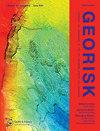Reliability-based optimization in climate-adaptive design of embedded footing
IF 4.8
3区 工程技术
Q1 ENGINEERING, GEOLOGICAL
Georisk-Assessment and Management of Risk for Engineered Systems and Geohazards
Pub Date : 2022-06-13
DOI:10.1080/17499518.2022.2088801
引用次数: 1
Abstract
ABSTRACT This paper presents a quantitative framework to optimise embedded footing performance subjected to extreme historical climate events with respect to the uncertainties associated with site-specific soil and climatic parameters. The proposed framework is developed based on partially saturated soil mechanics principles in conjunction with a multi-objective optimisation algorithm called Non-dominated Sorting Genetic Algorithm (NSGA-II) to develop a robust optimised design procedure. The proposed method was applied to two semi-arid climate sites, Riverside and Victorville, both situated in California, United States. The results show that the proposed method generally improves the embedded footing design compared to conventional methods in terms of cost and performance. Based on the findings, under the extreme climate conditions, the proposed method estimates the average soil degree of saturation within the footing influence zone between 52% and 95%, with a mean value of 63.1% for the Victorville site, and 57% and 90% with a mean value of 81.6% for the site in Riverside. It is also found that the optimal design from the proposed method shows a lower total construction cost, 44% and 19%, for the Victorville and Riverside sites, respectively, compared to the ones designed by the conventional methods.基于可靠性的嵌入式基础气候适应性设计优化
本文提出了一个定量框架,以优化受极端历史气候事件影响的嵌入式基础性能,考虑与场地特定土壤和气候参数相关的不确定性。提出的框架是基于部分饱和土力学原理,结合称为非主导排序遗传算法(NSGA-II)的多目标优化算法开发的,以开发稳健的优化设计程序。所提出的方法被应用于两个半干旱气候地点,河滨和维克多维尔,都位于美国加利福尼亚州。结果表明,与传统方法相比,该方法在成本和性能方面总体上改善了嵌入式基础设计。根据研究结果,在极端气候条件下,本文方法估计的立基影响区内土壤平均饱和度在52% ~ 95%之间,其中Victorville场地的平均值为63.1%,Riverside场地的平均值为57% ~ 90%,平均值为81.6%。研究还发现,与传统方法设计的站点相比,采用该方法设计的Victorville和Riverside站点的总施工成本分别降低了44%和19%。
本文章由计算机程序翻译,如有差异,请以英文原文为准。
求助全文
约1分钟内获得全文
求助全文
来源期刊
CiteScore
8.70
自引率
10.40%
发文量
31
期刊介绍:
Georisk covers many diversified but interlinked areas of active research and practice, such as geohazards (earthquakes, landslides, avalanches, rockfalls, tsunamis, etc.), safety of engineered systems (dams, buildings, offshore structures, lifelines, etc.), environmental risk, seismic risk, reliability-based design and code calibration, geostatistics, decision analyses, structural reliability, maintenance and life cycle performance, risk and vulnerability, hazard mapping, loss assessment (economic, social, environmental, etc.), GIS databases, remote sensing, and many other related disciplines. The underlying theme is that uncertainties associated with geomaterials (soils, rocks), geologic processes, and possible subsequent treatments, are usually large and complex and these uncertainties play an indispensable role in the risk assessment and management of engineered and natural systems. Significant theoretical and practical challenges remain on quantifying these uncertainties and developing defensible risk management methodologies that are acceptable to decision makers and stakeholders. Many opportunities to leverage on the rapid advancement in Bayesian analysis, machine learning, artificial intelligence, and other data-driven methods also exist, which can greatly enhance our decision-making abilities. The basic goal of this international peer-reviewed journal is to provide a multi-disciplinary scientific forum for cross fertilization of ideas between interested parties working on various aspects of georisk to advance the state-of-the-art and the state-of-the-practice.

 求助内容:
求助内容: 应助结果提醒方式:
应助结果提醒方式:


